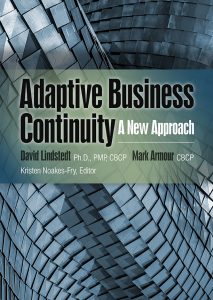(Re)introducing Adaptive Business Continuity
by Mark Armour, cABCF
My 2024 ended with two rather unexpected realizations: 1) that there are a lot of people out there who have never heard of Adaptive Business Continuity, and 2) many inaccurate perspectives of it still exist. Today, I start the journey of reintroducing my colleagues to Adaptive Business Continuity, and set the record straight.
Many articles have been written by me and my fellow Adaptive Business Continuity conspirator, David Lindstedt, over the years (all of which are accessible here). An argument could be made that there is already sufficient content available, making further exploration of Adaptive BC concepts and principles unnecessary. While that may be true, my thinking and approach to articulating Adaptive BC have changed considerably since its inception. As a result, I believe there is tremendous benefit in revisiting this territory and sharing it from a new perspective and with a different voice.
In future articles, I intend to dive into specific aspects of Adaptive BC. I will explore the meaning behind the language we use, what makes it distinct from the traditional view of preparedness, and, perhaps most importantly, what it offers the practitioner. To begin, I’d like to address a few misconceptions that have come to my attention. I’ve chosen four, specifically, that were articulated via summaries that I requested from ChatGPT and Claude Sonnet 3.5. I have heard similar perspectives voiced over the years, which reinforces my belief that these are pretty common beliefs and not merely hallucinated by AI.
Adaptive BC aims to simplify BC practices and reduce documentation
I have heard Adaptive BC described as a shortcut. This implies that Adaptive BC is little more than an abbreviated version of the well-known business continuity lifecycle. In truth, Adaptive is a re-imagining of how preparedness work should be done. I’ve often described the resulting methodology as: measure capability > improve capability > re-measure. From a process perspective, this is arguably simpler. However, this approach requires significantly more effort from the practitioner. How capabilities might be measured can vary, and, improvement can take many different forms, necessitating drastically different actions, each of which requires different skills and expertise to navigate.
Adaptive BC is designed to provide a framework that delivers better outcomes when organizations deal with losses. The result may be a reduction in documentation (something I greatly favor), but that is not a stated goal of Adaptive BC.
Prioritizing services or processes is a component of Adaptive BC
Many Adaptive BC proponents still emphasize the need to prioritize services to define program scope or sequence recovery efforts. I do not. Nor is this mentioned anywhere within the Adaptive BC Manifesto or the book. I have argued many times that trying to define priorities for the resumption of services is wasted effort. Many activities can take place in parallel, and priorities will change when disasters occur. This was the experience of nearly every practitioner following the emergence of COVID-19 and the subsequent governmental lockdowns and health authority mandates. Yes, priorities may be defined in accordance with Adaptive BC Principles, but they are not a stated component of the Adaptive BC framework.
Adaptive BC advocates testing and reliance on lessons learned
I was surprised to see the word testing within the summary of Adaptive provided by ChatGPT. This is because one of the Adaptive BC Principles is titled “Exercise for Improvement, not for Testing.” As this Principle states: “Exercises should be used to support the continuous improvement of response and recovery capabilities. They should neither be used as tests of recoverability nor as reviews of planning documentation.” Exercises are opportunities for teams to practice, improve their competence, and identify areas for improvement. You won’t find any use of the term “lessons learned” within the manifesto, and it is seldom referenced as an outcome of exercise activities within the Adaptive BC literature. As with prioritizing services, this may be done following Adaptive BC Principles, but it is not at all necessary to be aligned with Adaptive BC.
Adaptive emphasizes the improvement of strategies
I would love for our profession to stop using the term “plan.” Seeing the word “strategy” in its place is at least a step in the right direction. However, I don’t see strategy improvement as a key outcome of Adaptive BC efforts. I would not go so far as to say that having clearly defined recovery strategies is of no benefit. What I would say is that strategies only provide benefits to competent and empowered teams that are armed with the necessary resources to carry out the mission. For this reason, I always emphasize the importance of focusing efforts on capabilities and consider plans and strategies as little more than supporting materials for any business continuity program. The improvement of strategies or plans is not a guaranteed outcome of Adaptive Business Continuity (BC) BC work.
There is more, to be sure, but these four cover the most common – and most significant – misinterpretations of Adaptive Business Continuity. There is much more to say, so stay tuned. I intend to explore specific aspects of Adaptive BC, along with my recommendations for ensuring the greatest likelihood of success. In the meantime, stay curious!
==================================================
MARK ARMOUR is an i

